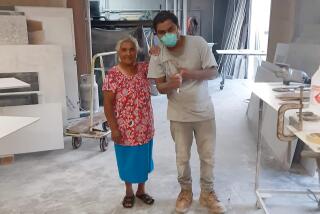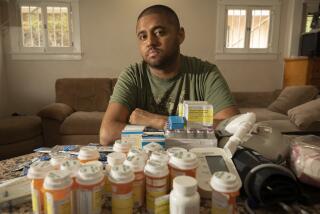Coming Up Roses
When Maria Silis looks in the mirror now, she is happy.
She sees past the stitches and shaved area of her scalp to focus on what is now missing--a fleshy tumor behind her ear. The tumor had taken over the right side of her face, pushing down an eyebrow, pulling at her bottom eyelid and muffling her hearing.
“I feel normal now,” she said from her bed at St. Joseph Hospital in Orange, her smile accented by a bouquet of red roses from her 9-year-old daughter.
The benign tumor, caused by a rare genetic disease, was removed Monday during a four-hour operation that the 29-year-old woman has known for years that she needed, but could not afford.
So St. Joseph Hospital and Dr. Simon J. Madorsky donated their services in an effort to restore Silis’ appearance and stem the vision and hearing problems the tumor was causing.
Silis, who lives in Garden Grove, suffers from neurofibromatosis, also known as von Recklinghausen’s disease. The disease causes fibrous tumors, called neurofibromas, to grow from nerve tissue, thickening the skin and making it grow heavy. At the same time, it infiltrates muscles and other tissues.
“Unabated, it can actually make the skin pull away from the face and become like an appendage, with skin hanging down as if it were melting,” said Madorsky, a plastic surgeon.
Neurofibromas are not cancerous, but they are quite invasive and can cause problems with the tissues they infiltrate, Madorsky said. Despite growing from nerve tissue, they generally are not painful.
During the surgery, Madorsky cut the tumor away from the skin and muscles and lifted the skin--essentially the technique that is used for cosmetic eye-lifts. It’s a strange turn of events, he said, because surgeons generally develop procedures for reconstructive surgery first before adapting them to cosmetic surgery.
“This is sort of topsy-turvy,” he said.
He could not completely remove Silis’ tumor because it had grown into major facial nerves and muscles used for chewing.
“To completely remove it would mean injuring those structures,” Madorsky said. “The idea was to get her to have some semblance of normality [in appearance] so that she can go out in public.”
Silis is not cured. The tumor will inevitably grow back, but she probably will not need surgery for another 10 years, the doctor said.
Further, two of her three children already have shown symptoms of the disease. Two-year-old Victor has a growth on an upper eyelid. Daughter Guadalupe, 9, has freckling and birthmarks that are manifestations of the disease, and she could develop tumors later. A second son, 8-year-old Raul, shows no signs of the disease.
*
Though Silis has been living with her growing tumor for 13 years, she has only recently begun to understand the true nature of her condition.
She believed the growth was a result of facial injuries she suffered in the 1985 Mexico City earthquake, when the building she was in tumbled around her.
About 10 years ago, doctors in Mexico operated on her face “and she thinks it was for her injuries, but now I’m convinced they did it for the tumor,” Madorsky said. “For her, it is one continuum of events.”
Silis said Tuesday she is still a bit confused. She was convinced her facial disfigurement was caused somehow by the earthquake but “the doctors told me something else.”
“I don’t understand what they told me, but they said it was genetic and one of my children already has signs of the same problem,” she said. “But I don’t know what to believe.”
Silis’ condition was first noticed at La Amistad Family Health Center, a charity clinic St. Joseph operates for the poor. Silis was seeking treatment for stomach pains, but the medical staff immediately zeroed in on the facial problem. Referred to a specialist, the unemployed widow was told two years ago that it would cost $4,000 for the surgery.
La Amistad officials did not give up. They put a notice in a St. Joseph Hospital newsletter, seeking a plastic surgeon or neurologist to take Silis on pro bono. Madorsky, whose surgical fee alone probably would have been closer to $6,000, agreed. He had treated one neurofibromatosis patient before.
La Amistad and St. Joseph will continue to work with Silis, help her son receive treatment and provide genetic counseling for Silis herself, who has a 50% chance of passing the neurofibromatosis gene on if she has more children.
Silis possibly will go home later today but has no plans for a wild celebration. Shy and still on pain medication, she was reluctant Tuesday to discuss how her restored face will affect her life.
She said she is deeply grateful to her doctor, the hospital and Angela Acevedo, a nurse at La Amistad who took the family under her wing. The surgery has made her feel normal and contented, she said, shaking her head at the idea the procedure was purely cosmetic.
“No, no,” she said. “This was more important than that . . . to me.”
More to Read
Sign up for Essential California
The most important California stories and recommendations in your inbox every morning.
You may occasionally receive promotional content from the Los Angeles Times.










